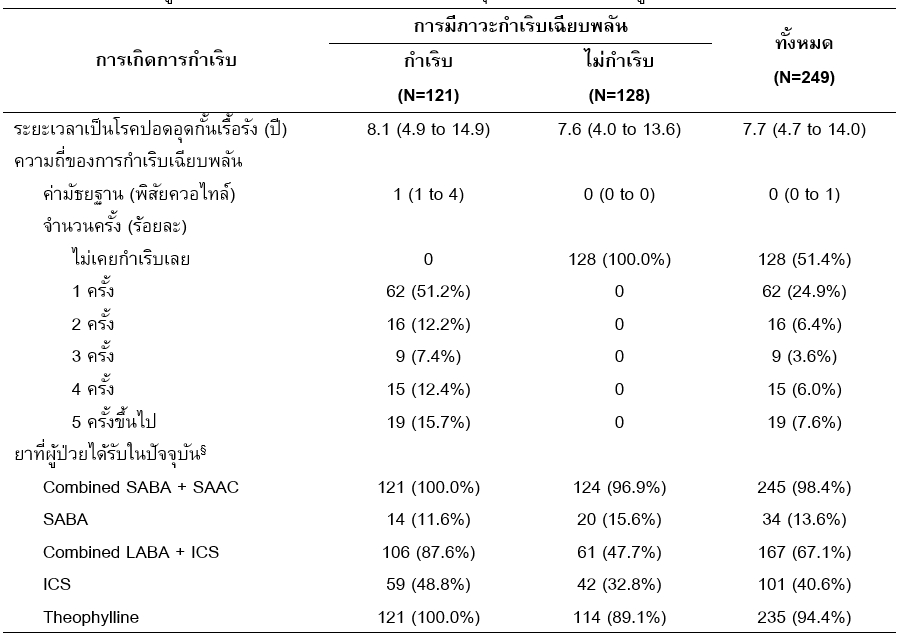ความชุกและปัจจัยที่สัมพันธ์กับการกำเริบเฉียบพลันของผู้ป่วยโรคปอดอุดกั้นเรื้อรังในโรงพยาบาลชุมชน
คำสำคัญ:
โรคปอดอุดกั้นเรื้อรัง, การกำเริบเฉียบพลัน, ความชุก, โรงพยาบาลชุมชนบทคัดย่อ
การศึกษานี้มีวัตถุประสงค์เพื่อหาความชุกและปัจจัยที่สัมพันธ์กับการกำเริบเฉียบพลันของผู้ป่วยโรคปอดอุดกั้นเรื้อรัง โดยเป็นการศึกษาแบบย้อนหลัง (retrospective study) ในผู้ป่วยโรคปอดอุดกั้นเรื้อรังที่ได้รับการวินิจฉัยและลงทะเบียนการรักษาในคลินิกโรคปอดอุดกั้นเรื้อรัง ณ โรงพยาบาลจุน จังหวัดพะเยา ซึ่งทำการเก็บข้อมูลจากเวชระเบียนระหว่างวันที่ 1 ตุลาคม พ.ศ. 2561 ถึงวันที่ 30 เมษายน พ.ศ. 2563 จำนวน 249 ราย และวิเคราะห์ผลโดยใช้การถดถอยโลจิสติกและการถดถอยทวินามลบทั้งแบบตัวแปรเดี่ยวและพหุตัวแปร เพื่อศึกษาความสัมพันธ์ระหว่างปัจจัยต่าง ๆ ได้แก่ อายุ ความดันโลหิต ดัชนีมวลกาย ระยะเวลาการเป็นโรคปอดอุดกั้นเรื้อรัง ประวัติการสูบบุหรี่ ประวัติการดื่มแอลกอฮอล์ การมีโรคร่วม อาชีพ ยาและขนาดยาที่ผู้ป่วยได้รับในการรักษาโรคปอดอุดกั้นเรื้อรัง ต่อความเสี่ยงและความถี่ในการกำเริบของโรคปอดอุดกั้นเรื้อรัง โดยผลการศึกษาพบว่า ความชุกของการกำเริบของโรคในระหว่างการเก็บข้อมูลสูงถึงร้อยละ 48.6 โดยปัจจัยที่สัมพันธ์กับความเสี่ยงของการกำเริบเฉียบพลันที่สูงขึ้น ได้แก่ การได้รับยาขยายหลอดลมกลุ่ม beta2 agonists ร่วมกับยาสเตียรอยด์ (Odds ratio 7.14 [95%CI 1.78 ถึง 28.66]) สำหรับปัจจัยที่สัมพันธ์กับความถี่ในการกำเริบของโรคที่ลดลง ได้แก่ ระยะเวลาการเป็นโรคปอดอุดกั้นเรื้อรัง (Incidence rate ratio ต่อหนึ่งปีที่เป็นโรคยาวนานขึ้น 0.77 [95%CI 0.71 ถึง 0.83]) และการดื่มสุรา (Incidence rate ratio 0.12 [95%CI 0.02 ถึง 0.64]) แม้ความสัมพันธ์ที่พบอาจเป็นผลจากความสัมพันธ์ย้อนกลับและอคติจากการรอดชีพ แต่ความชุกของการกำเริบของโรคที่สูง โดยเฉพาะอย่างยิ่งในผู้ป่วยที่เพิ่งได้รับการวินิจฉัยซึ่งพบว่าสัมพันธ์กับความถี่ในการกำเริบที่สูง อาจบ่งชี้ถึงความจำเป็นในการวางแผนติดตามที่ใกล้ชิดขึ้นหรือการให้การรักษาที่เข้มงวดขึ้นในผู้ป่วยกลุ่มนี้ต่อไป
References
Barbara W, Joseph D, Terry S, Cecily D. Pharmacotherapy handbook. 9th ed. New York]: McGraw-Hill Education; 2014.
World Health Organization. Chronic obstructive pulmonary disease (COPD) [Internet]. [cited 2021 Apr 18]. Available from: http://www.emro.who.int/health-topics/chronic-obstructive-pulmonary-disease-copd/index.html
Mathers CDD, Loncar D. Projections of global mortality and burden of disease from 2002 to 2030. PLoS Med. 2006;3(11):e442.
Service Plan COPD. Guideline for the management of chronic obstructive pulmonary disease (COPD). Phayao: Phayao Provincial Public Health Office in collaboration with Phayao Hospital; 2020.
Müllerova H, Maselli DJ, Locantore N, Vestbo J, Hurst JR, Wedzicha JA, et al. Hospitalized exacerbations of COPD: risk factors and outcomes in the ECLIPSE cohort. Chest. 2015;147(4):999–1007.
Roberts M, Mapel D, Von Worley A, Beene J. Clinical factors, including all patient refined diagnosis related group severity, as predictors of early rehospitalization after COPD exacerbation. Drugs Context. 2015;4:1–15.
Global Initative for Chronic Obstructive Lung Disease. Global strategy for the diagnosis, management, and prevention of chronic obstructive pulmonary disease 2021 report [Internet]. 2021 [cited 2021 Aug 10]. Available from: https://goldcopd.org/wp-content/uploads/2020/11/GOLD-REPORT-2021-v1.1-25Nov20_WMV.pdf
Guideline for the treatment of chronic obstructive pulmonary disease 2017. Bangkok: Thoracic Society of Thailand Under Royal Patronage; 2017.
Hwang Y Il, Lee SH, Yoo JH, Jung BH, Yoo KH, Na MJ, et al. History of pneumonia is a strong risk factor for chronic obstructive pulmonary disease (COPD) exacerbation in South Korea: the Epidemiologic review and Prospective Observation of COPD and Health in Korea (EPOCH) study. J Thorac Dis. 2015;7(12):2203–13.
Garcia-Aymerich J, Farrero E, Félez MA, Izquierdo J, Marrades RM, Antó JM. Risk factors of readmission to hospital for a COPD exacerbation: a prospective study. Thorax. 2003;58(2):100–5.
García-Sanz MT, Pol-Balado C, Abellás C, Cánive-Gómez JC, Antón-Sanmartin D, González-Barcala FJ. Factors associated with hospital admission in patients reaching the emergency department with COPD exacerbation. Multidiscip Respir Med. 2012;7(1):6.
Alexopoulos EC, Malli F, Mitsiki E, Bania EG, Varounis C, Gourgoulianis KI. Frequency and risk factors of COPD exacerbations and hospitalizations: a nationwide study in Greece (Greek Obstructive Lung Disease Epidemiology and health ecoNomics: GOLDEN study). Int J Chron Obstruct Pulmon Dis. 2015;10:2665–74.
Pothirat C, Pothirat T, Liwsrisakun C, Bumroongkit C, Deesomchok A, Theerakittikul T, et al. Risk factors of severe acute exacerbation of chronic obstructive pulmonary disease among patients regularly managed by pulmonologists. J Med Assoc Thai. 2017;100(2):142–8.
Vatcheva KP, Lee M, McCormic JB, Rahbar MH. Multicollinearity in regression analyses conducted in epidemiologic studies. Epidemiology. 2016;6(2):1–9.
Sterne JAC, White IR, Carlin JB, Spratt M, Royston P, Kenward MG, et al. Multiple imputation for missing data in epidemiological and clinical research: potential and pitfalls. BMJ. 2009;338:b2393.
Carpenter J, Kenward M. Multiple imputation and its application. Chichester, United Kingdom: John Wiley & Sons; 2013.
Calverley PMA, Anderson JA, Celli B, Ferguson GT, Jenkins C, Jones PW, et al. Salmeterol and fluticasone propionate and survival in chronic obstructive pulmonary disease. N Engl J Med. 2007;356(8):775–89.
Palanupap K, Wacharamaneekan K, Khameiad T, Treetrisit P, Kantasa P, Chowjiriyapan K, et al. Risk factors associated 28-day readmission for a chronic obstructive pulmonary disease exacerbation. Naresuan Phayao Journal. 2016;9(2):13–6.
Peduzzi P, Concato J, Kemper E, Holford TR, Feinstein AR. A simulation study of the number of events per variable in logistic regression analysis. J Clin Epidemiol. 1996;49(12):1373–9.
Muraki M, Kunita Y, Shirahase K, Yamazaki R, Hanada S, Sawaguchi H, et al. A randomized controlled trial of long-acting muscarinic antagonist and long-acting β2 agonist fixed-dose combinations in patients with chronic obstructive pulmonary disease. BMC Pulm Med. 2021;21(1):1–8.
Calverley PMA, Anzueto AR, Carter K, Grönke L, Hallmann C, Jenkins C, et al. Tiotropium and olodaterol in the prevention of chronic obstructive pulmonary disease exacerbations (DYNAGITO): a double-blind, randomised, parallel-group, active-controlled trial. Lancet Respir Med. 2018;6(5):337–44.
Buhl R, Maltais F, Abrahams R, Bjermer L, Derom E, Ferguson G, et al. Tiotropium and olodaterol fixed-dose combination versus mono-components in COPD (GOLD 2-4). Eur Respir J. 2015;45(4):969–79.

Downloads
เผยแพร่แล้ว
How to Cite
ฉบับ
บท
License
Copyright (c) 2022 วารสารนเรศวรพะเยา

This work is licensed under a Creative Commons Attribution-NonCommercial-NoDerivatives 4.0 International License.
ผู้นิพนธ์ต้องรับผิดชอบข้อความในบทนิพนธ์ของตน มหาวิทยาลัยพะเยา ไม่จำเป็นต้องเห็นด้วยกับบทความที่ตีพิมพ์เสมอไป ผู้สนใจสามารถคัดลอก และนำไปใช้ได้ แต่จะต้องขออนุมัติเจ้าของ และได้รับการอนุมัติเป็นลายลักษณ์อักษรก่อน พร้อมกับมีการอ้างอิงและกล่าวคำขอบคุณให้ถูกต้องด้วย






